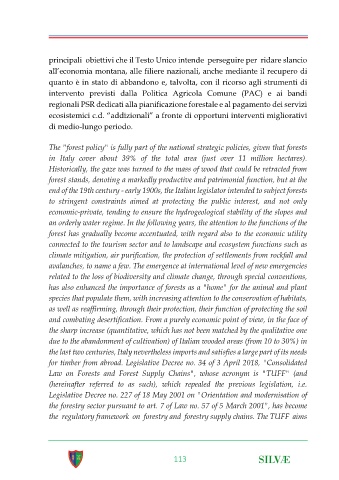Page 113 - ok rivista silvae dicembre 2024
P. 113
principali obiettivi che il Testo Unico intende perseguire per ridare slancio
all’economia montana, alle filiere nazionali, anche mediante il recupero di
quanto è in stato di abbandono e, talvolta, con il ricorso agli strumenti di
intervento previsti dalla Politica Agricola Comune (PAC) e ai bandi
regionali PSR dedicati alla pianificazione forestale e al pagamento dei servizi
ecosistemici c.d. “addizionali” a fronte di opportuni interventi migliorativi
di medio-lungo periodo.
The "forest policy" is fully part of the national strategic policies, given that forests
in Italy cover about 39% of the total area (just over 11 million hectares).
Historically, the gaze was turned to the mass of wood that could be retracted from
forest stands, denoting a markedly productive and patrimonial function, but at the
end of the 19th century - early 1900s, the Italian legislator intended to subject forests
to stringent constraints aimed at protecting the public interest, and not only
economic-private, tending to ensure the hydrogeological stability of the slopes and
an orderly water regime. In the following years, the attention to the functions of the
forest has gradually become accentuated, with regard also to the economic utility
connected to the tourism sector and to landscape and ecosystem functions such as
climate mitigation, air purification, the protection of settlements from rockfall and
avalanches, to name a few. The emergence at international level of new emergencies
related to the loss of biodiversity and climate change, through special conventions,
has also enhanced the importance of forests as a "home" for the animal and plant
species that populate them, with increasing attention to the conservation of habitats,
as well as reaffirming, through their protection, their function of protecting the soil
and combating desertification. From a purely economic point of view, in the face of
the sharp increase (quantitative, which has not been matched by the qualitative one
due to the abandonment of cultivation) of Italian wooded areas (from 10 to 30%) in
the last two centuries, Italy nevertheless imports and satisfies a large part of its needs
for timber from abroad. Legislative Decree no. 34 of 3 April 2018, "Consolidated
Law on Forests and Forest Supply Chains", whose acronym is "TUFF" (and
(hereinafter referred to as such), which repealed the previous legislation, i.e.
Legislative Decree no. 227 of 18 May 2001 on "Orientation and modernisation of
the forestry sector pursuant to art. 7 of Law no. 57 of 5 March 2001", has become
the regulatory framework on forestry and forestry supply chains. The TUFF aims
113

